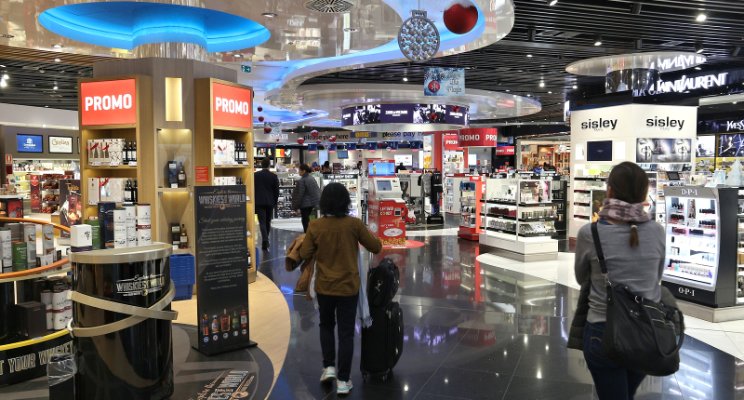Years ago, I endured a long layover at the Detroit airport. It was cramped, noisy, outdated and humid. I vowed never to fly through Detroit if I could possibly avoid it.
However, I passed through the Motor City’s airport more recently and what a difference a new terminal can make. The gleaming space is light and airy, with a bright red tram whisking passengers from one end to the other like something out of a sci-fi movie. To get to a different terminal, I strolled through an underground tunnel lined with a glass sculpture that changed colors to ethereal music.
Now, I rather look forward to passing through Detroit again.
Detroit’s airport is an example of a trend toward making terminals more pleasant and easier for passengers to navigate. Why would an airport care about this? Because relaxed travelers with time on their hands will spend more money at airport stores and restaurants — about 7 percent more on retail and 10 percent more in duty free shops. They’ll also come away with positive feelings about the airport and the city it is located in – even if they never set foot beyond the security checkpoint.
Positive Emotions Drive Spending
Air travel is stressful. Your checked bag must be under a certain weight. Security lines can be distressingly long, putting you in danger of missing your flight. Unfamiliar airports are challenging to navigate. Flights get delayed, overbooked or cancelled. Add in traffic on the way to the airport, rental car drop-offs, and overcrowded waiting areas and you’ve got a recipe for anxiety, frustration and general unhappiness.
These are negative emotions and they spell trouble for the overall customer experience. Our research demonstrates how emotions can significantly drive or destroy value. Air passengers who are filled with negative emotions might spend money on chocolate bars and Auntie Ann’s pretzels but they’re not going to buy high-end items at airport boutiques or linger over a meal in a sit-down restaurant. And, as with my impression of Detroit, they’re not going to have a good memory of the airport or the city it’s located in.
5 Ways Airports are Changing the Traveler Experience
Airports are pursuing a variety of strategies to reduce travelers’ negative emotions and improve their subconscious and emotional experience. These include:
1. Helping you find your way with color-coded, easy to read signs and memorable art installations. Modern airports have plenty of windows looking out onto the tarmac, so you always have a sense of where you are in relation to the airplanes.
2. Giving You Leisure Time. Automated check-in kiosks are designed to get passengers past the security checkpoint more quickly. This reduces the anxiety created by long lines, but it also encourages passengers to spend money in the “golden hour” after they clear security and before it’s time to board. Display boards that show gates and departure times make it easy for passengers to see that they have plenty of time to shop or eat.
3. Making shops pleasant and easy to find by clustering them, shopping mall style, in certain areas of the airport. Increasingly, shops include windows (or face them) so they receive natural light. It turns out that most people don’t want to hang out in a dark and claustrophobic shop before boarding a plane!
4. Making boarding areas more pleasant. Carpeting in boarding areas muffles noise and supposedly gives the boarding area a homier feel, though I question whether a boarding area can ever exactly feel “homey.”
5. Helping you feel a sense of place. In one survey, 56 percent of respondents said they’d like to see a more authentic, location-based experience in airports. This brings to mind Las Vegas, where you can play the slots (and lose all your money!) as soon as you deplane. But in most airports, a local flavor might include exhibits, displays, and shops selling locally produced food and goods.
As a customer experience consultant and frequent traveler, I’m glad to see airports making an effort to improve the passenger experience. But with high passenger volume, airline cost-cutting measures, carry-on baggage restrictions and ever-changing security and airline rules, flying can still be stressful and unpleasant. I wonder whether airport initiatives alone can make passengers relaxed and happy enough to spend more money.
Do you think the airport experience has improved? What else could airports do to improve? Share your thoughts in the comments box below.
To read more about emotions in the Customer Experience read The Intuitive Customer: 7 Imperatives to moving your Customer Experience to the next level. My latest book, co-authored with Professor Ryan Hamilton of Emory University, describes where Behavioral Economics meets Customer Experience in an easy to understand and practical way.
If you enjoyed this blog, you might also want to read these:
Cost-Cutting Airlines – Headed for Trouble!
PR Nightmare! What United Should Have Done
Cheap Airlines: Low Prices! Terrible Service! Can They Change?
Colin Shaw is the founder and CEO of Beyond Philosophy, one of the world’s leading Customer experience consultancy & training organizations. Colin is an international author of six bestselling books and an engaging keynote speaker.
Follow Colin Shaw on Twitter @ColinShaw_CX


